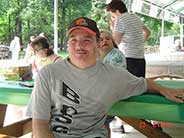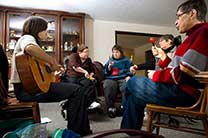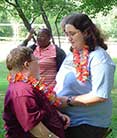That’s when they heard about a pilot project begun by the Ohio Department of Mental Retardation in 1987 to encourage parents of people with developmental disabilities to start family consortium homes, also known as family directed housing.
Annie, Terrie, and Luanne’s parents formed a corporation and discussed how to provide a home and support services for their daughters. The first step was to submit a proposal bid to the county. Once the proposal was approved, they pooled financial resources and purchased a condominium. The state paid the families a fixed amount each year to cover the cost of direct support staff. The parents covered all other expenses.
The three friends flipped a coin to decide which bedroom they would get. They shared chores and prepared meals together. For the first few years, their parents hired and directly managed the staff who worked in the home. This proved to be exhausting, so they decided to contract with a provider agency for the services.
Seventeen years later, Annie, Terrie, and Luanne still live together. The women explain that when they first moved in, they felt “a little weird,” but soon settled in with one another. Now, they share the responsibilities of caring for their home and making decisions together. They meet regularly with a social worker to help them work out any conflicts or problems.
At first, they spent a great deal of time together outside the home. As the years passed, they developed their own interests, often socialize with other friends, and “do their own thing.”
Living together, the women admit, has not been without struggles or frustration, but they are glad that they can live with people they “really get along with” – in a home all their own.
Residential Options Overview
You may decide to create family directed housing for your child like Annie, Terrie, and Luanne’s families did, or you might choose a traditional residential service for your child.
Residential services fall on a continuum from the traditional, most restrictive options to the family directed, least restrictive options.
Depending on which option you and your child decide is right for your family, your child (the resident) will have varying degrees of control over such things as access to personal funds, opportunities for community involvement, choice of service providers, and so on.
How Do You—And Your Child—Fit into the System?
With all its complexities and rules, the intellectual and developmental disabilities (IDD) services system has been slow to change. It has, however, made a big philosophical shift in its approach to individuals with intellectual disabilities.
The system now dictates individuals should have as much control as possible over their life, regardless of disability. This includes managing a home and support services.
For individuals whose disabilities make such control impossible, parents or other family members should assist.
You Are Quality Control
By contributing to your child’s services, you function as an important part of quality control. You can bring your observations and concerns to staff and government officials, ensuring a safe home and good quality of life for your child.
Without this support, your child might wait years to receive services or be unable to earn enough money to live a reasonable lifestyle. Public agencies have to divide a shrinking sum of money among all of the people needing housing or support services.
If you are unable to contribute financially, you can still influence the quality of services provided by being a part of your child’s support network and decision-making process.
You should work with your child in making all decisions about his or her future.
IMPORTANT REMINDER!
No matter which residential option your family chooses, you can still participate in the planning and maintenance of a safe, happy home for your child.
At the very least, you should be involved in developing a life plan for your child.
You and your family play a critical role in assuring quality support services, regardless of the setting in which they live. Much of the information in subsequent sections of this guide—on building a circle of support, writing a letter of intent, and linking with other families, for instance—can be useful no matter the residential choice.













